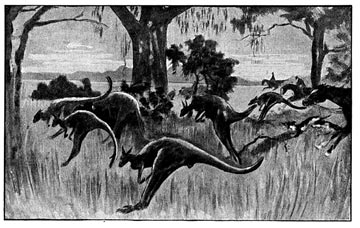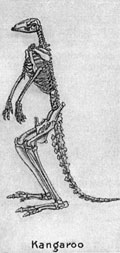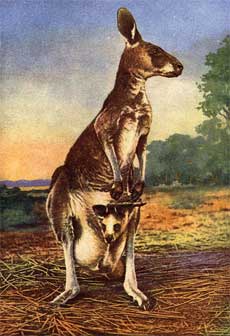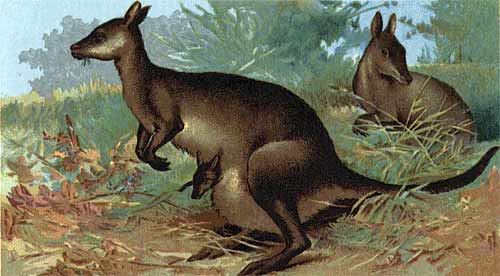|

Legs and Pouch: Kangaroos have large, powerful hind legs, large feet adapted for leaping, a long muscular tail for balance, and a small head. Like all marsupials, kangaroos have a pouch called a marsupium in which their young complete their development after birth.

 Hopping: Kangaroos are the only large animals to use hopping as a means of locomotion. The comfortable hopping speed for Red kangaroos is about 20–25 km/h (13–16 mph), but they can hop as fast as 70 km/h (43 mph) over short distances. Hopping: Kangaroos are the only large animals to use hopping as a means of locomotion. The comfortable hopping speed for Red kangaroos is about 20–25 km/h (13–16 mph), but they can hop as fast as 70 km/h (43 mph) over short distances.
This fast and energy-efficient method of travel has evolved less in response to the danger of predators, but more because of the need to regularly cover large distances in search of food and water.
Unlike that of many other mammals, a kangaroo's scrotum is located far ahead of the penis, almost in the middle of the belly. In hot weather it can be seen lowered by the relaxed animal to keep the testes cool, and raised when moving about.
Life Span: The average life expectancy of a kangaroo is about 9-18 years, with some living until they are about 28.
What's for Dinner?: Kangaroos are large herbivores, feeding on grass and roots, and they chew cud. Their heads in fact look much like those of llamas. All species are nocturnal and crepuscular, usually spending the days idling quietly and the cool evenings, nights and mornings moving about and feeding, typically in mobs.
Mobs of Males: A mob may have ten or more males and females. The dominant male (called a boomer) is based on his size and age. A boomer has temporary exclusive access to females in a mob for mating. A boomer may find himself wandering in and out of a mob - checking out the females and intimidating the other males who try to mate with the females within the mob.

Predators? A few... Kangaroos have few natural predators. The Thylacine, considered by palaeontologists to have once been a major natural predator of the kangaroo, is now extinct. However, with the arrival of humans in Australia at least 50,000 years ago and introduction of the dingo about 5,000 years ago, kangaroos have had to adapt to introduced predators. The mere barking of a dog can set a full-grown male boomer into a wild frenzy. Wedge-tailed Eagles are opportunistic predators who may prey upon juvenile kangaroos and will attack and sometimes kill a kangaroo (even an adult Red), but only when no more suitably-sized food is available. Wedge-tailed Eagles and other raptors usually eat already deceased kangaroos and can be found feeding on road-kill. Goannas and other carnivorous reptiles also pose a danger to the smaller kangaroo species when other food sources are lacking.
Superb Swimmers: Along with dingoes and other canids, introduced species like foxes and feral cats also pose a threat to kangaroo populations, as they do most populations of native animals. Kangaroos and wallabies are apt swimmers, and often flee into waterways if presented with the option. If pursued into the water, a large kangaroo may use its forepaws to hold the predator underwater to drown it. Another defensive tactic described by witnesses is catching the attacking dog with the forepaws and disemboweling it with the hind legs.
 Energy Storage: Kangaroos and wallabies have a unique ability to store elastic strain energy in the tendons of their large hind legs. As a consequence, most of the energy required for each hop is provided by the spring action of the tendons rather than by muscular effort. There is also a linkage between the hopping action and breathing: as the feet leave the ground, air is expelled from the lungs; bringing the feet forward ready for landing fills the lungs again, providing further energy efficiency. Energy Storage: Kangaroos and wallabies have a unique ability to store elastic strain energy in the tendons of their large hind legs. As a consequence, most of the energy required for each hop is provided by the spring action of the tendons rather than by muscular effort. There is also a linkage between the hopping action and breathing: as the feet leave the ground, air is expelled from the lungs; bringing the feet forward ready for landing fills the lungs again, providing further energy efficiency.
Speed is Easy: Studies of kangaroos and wallabies have demonstrated that, beyond the minimum energy expenditure required to hop at all, increased speed requires very little extra effort (much less than the same speed increase in, say, a horse, a dog, or a human), and also that little extra energy is required to carry extra weight. For kangaroos, the key benefit of hopping is not speed to escape predators — the top speed of a kangaroo is no higher than that of a similarly-sized quadruped, and the Australian native predators are in any case less fearsome than those of other continents — the benefit is economy: in an infertile continent with very variable weather patterns, the ability of a kangaroo to travel long distances at moderately high speed in search of fresh pastures is crucial.

 Birds and Bees: Courtship behavior in most species of kangaroos includes the male "checking" the female's cloaca. The males are often rejected by the females for their smaller size, but in the case of a larger kangaroo, the female may instead simply move away. Birds and Bees: Courtship behavior in most species of kangaroos includes the male "checking" the female's cloaca. The males are often rejected by the females for their smaller size, but in the case of a larger kangaroo, the female may instead simply move away.
Often, when the female is being checked, it urinates. The male kangaroo will then make a practice of sniffing the urine multiple times until it is satisfied, then proceed to the mating cycle. Studies of kangaroo reproduction conclude that this ritual is typical for a male kangaroo to check if the female kangaroo is receptive to the male.
Come Hither Tail: The sexually aroused male follows the responsive female (she raises her tail). Tail scratching (a form of foreplay) can occur between the male and female. The arched tail is indicative that either one or both kangaroos are ready to mate. The male kangaroo may sometimes be found giving the female kangaroo a back rub before mating.
Marsupial Madness: As with all marsupials, the young are born at a very early stage of development after a gestation of 31-36 days. At this stage, only the forelimbs are somewhat developed, to allow the newborn to climb to the pouch and attach to a teat. In comparison, a human embryo at a similar stage of development would be about 7 weeks old, and premature babies born at less than 23 weeks are usually not mature enough to survive.
 Pampered in the Pouch: The joey will usually stay in the pouch for about 9 months or (for the Western Grey) 180 to 320 days, before starting to leave the pouch for small periods of time. It is usually fed by its mother until the age of 18 months. Pampered in the Pouch: The joey will usually stay in the pouch for about 9 months or (for the Western Grey) 180 to 320 days, before starting to leave the pouch for small periods of time. It is usually fed by its mother until the age of 18 months.
Permanently Pregnant: A female kangaroo is usually pregnant in permanence, except on the day she gives birth; however, she has the ability to freeze the development of an embryo until the previous joey is able to leave the pouch.
Mother's Milk: The composition of
the milk produced by the mother
varies according to the needs of the joey. In addition, she is able to simultaneously produce two different kinds of milk for the newborn and the older joey who still lives in the pouch.

There are three species:
The Red Kangaroo (Macropus rufus) is the largest surviving marsupial anywhere in the world. Fewer in numbers, the Red Kangaroos occupy the arid and semi-arid centre of the continent. A large male can be 2 metres (6 ft 6 in) tall and weigh 90 kg (200 lb).
The Eastern Grey Kangaroo (Macropus giganteus) is less well-known than the red (outside of Australia), but the most often seen, as its range covers the fertile eastern part of the continent.
The Western Grey Kangaroo (Macropus fuliginosus) is slightly smaller again at about 54 kg (119 lb) for a large male. It is found in the southern part of Western Australia, South Australia near the coast, and the Darling River basin.
In addition, there are over 60 smaller macropods that are closely related to the kangaroos in the family Macropodidae.
Pre-historic kangaroos:
Procoptodon
Sthenurus "Strong Tail"
Propleopus, carnivorous kangaroo during the pliocene and pleistocene periods (e.g. giant rat kangaroo)
Simosthenurus, leaf-eating (browsing) kangaroos

All text is available under the terms
of the GNU Free Documentation License
|